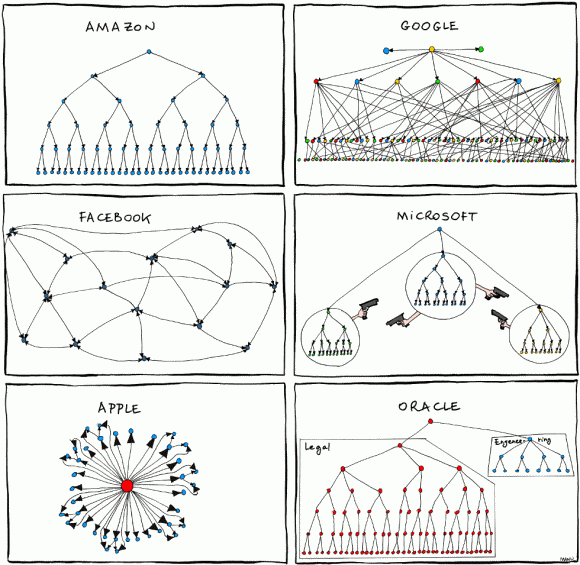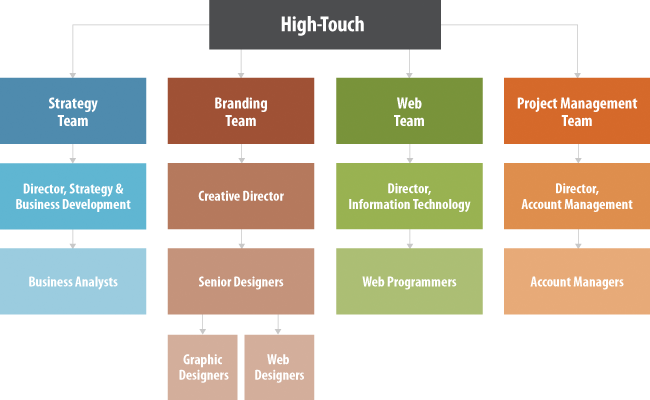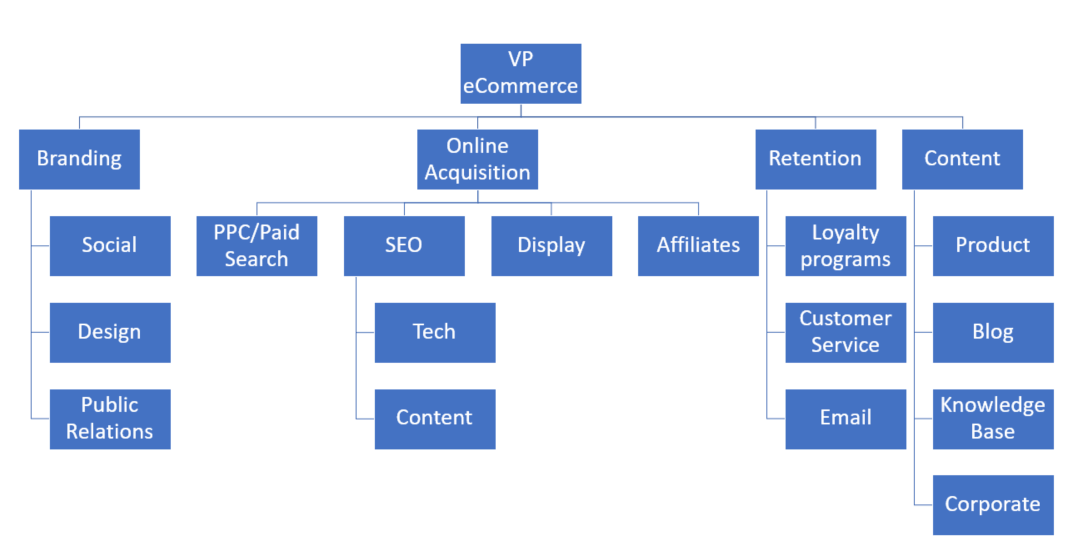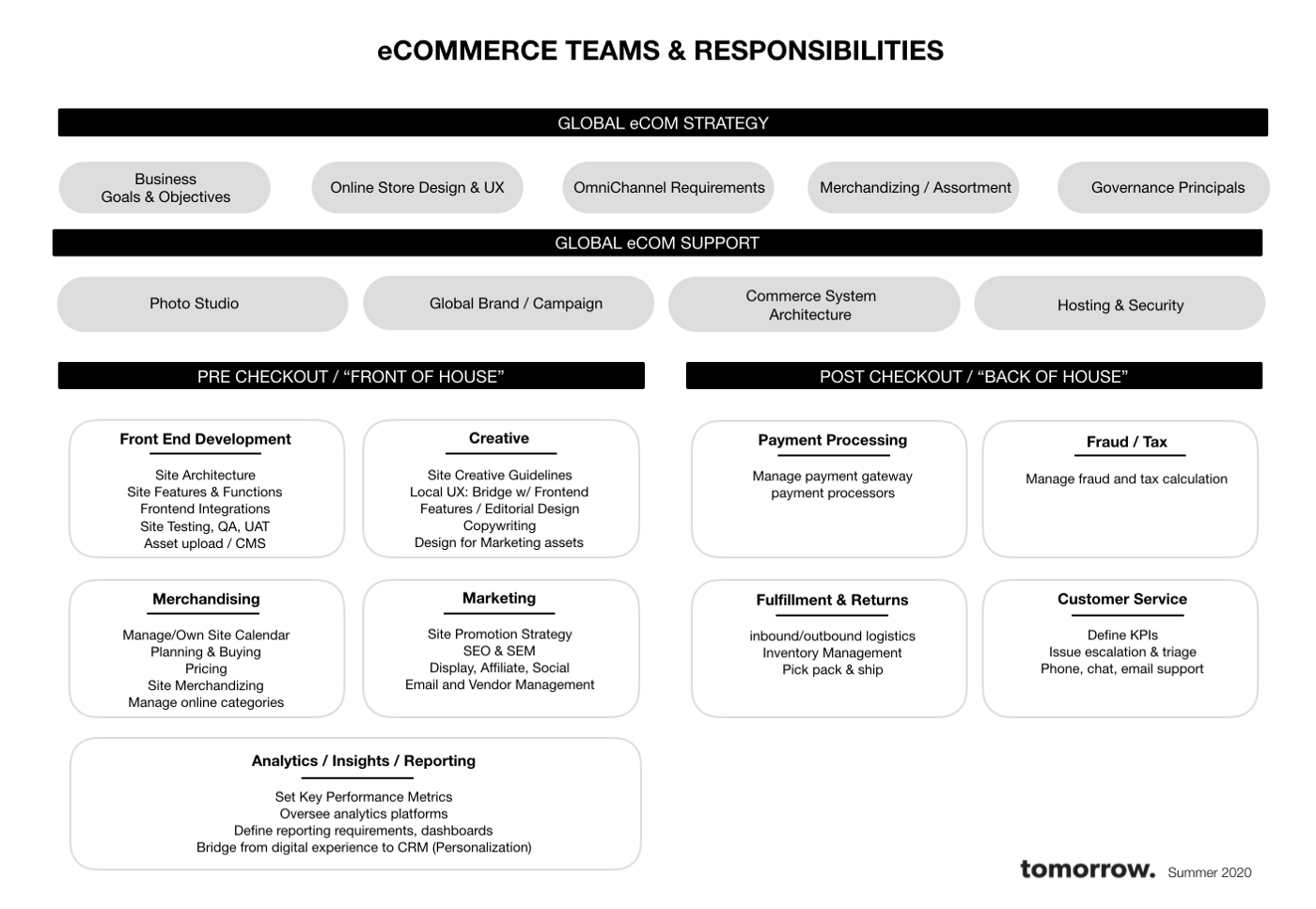A common question from our mid-to-large-sized clients is about how to structure their eCommerce teams. And one that we’re hearing at Tomorrow more frequently as companies put a renewed focus on Digital.
In my previous ~20 years experience being on eCommerce teams within Retail/Apparel Brands I’ve experienced many different organizational structures. Now as a cofounder of an agency, and as a Creative/UX guy at heart, I’m principally interested in recommending org structures that manage between Marketing, Merchandising, Creative, and Technology in a way that makes the whole operation hum along smoothly. Of all the pressure we have on us, the last thing slowing us down should be disorganization.
Obviously the first answer to this org-chart question is that many different structures work, and that there is no one system that can be applied across every team.
The second answer, also a bit of a throw-away, is that the organization of the eCom team is likely to follow the leadership style of the organization as a whole. Best illustrated by this classic sketch…

And the worst path you can take, which is why we get asked this question so often, is attempting to answer the org chart question by Googling. You’ll come across gems like this one, which may look good at first glance but surely has no indication of where strategies meet tactics — nor the division of responsibilities between teams — which is really the question we’re looking to answer.

You’ll also come across org charts that look more realistic, but are also secretly hiding formidable misunderstandings of how people work, like this diddy from an SEO agency (although +1 for driving me to their site):

First of all, we’ve seen $150M D2C brands who’ve achieved success with zero focus on Retention. And secondly, the baffling distinction between Branding and Content will be sure to get your creative teams at each other’s throats in no time.
Another level of fidelity upwards, I came across this one. I include it here because it tries to answer a couple questions that we hear often:
- Should Brand/Creative live in Marketing?
- And is UX part of Creative, or on it’s own, or is it within Front-End?

Unfortunately I couldn’t disagree more with this structure, regardless of the organization.
Rather, we’ve often ended up recommending structures like the below. Although this one was designed for a larger organization, there are a number of core principles here that apply to even the smallest teams.
One key difference in our org chart is that it outlines functions outside of the eCom team that provide strategy, resources, and other forms of tangible support. Even if your company isn’t literally global, the same term applies to these overarching support mechanisms.

1. Global Strategy
I think we’ve all worked in organizations that claim to have clear business goals and objectives, but if you asked around the table, your colleagues would struggle to give you anything other than “Drive 30% YoY Growth,” and the like. Every member of the eCom team (not just the C-suite) should be aligned on their objectives, and which should be revisited annually. Similarly, if you’re operating multiple sites, site design becomes a global function. You’re not redesigning the sites throughout the year, but rather making it perform better.
2. Global eCOM Support
When you’re in-house at a brand, it’s important to define what the organization owes you, and what you provide in return. Content creation often falls in this nebulous arena, and in the end, if this isn’t properly defined, it’s usually the eCom team that is scrambling to make something work.
3. Front of House vs. Back of House
I personally like these terms because they apply to the physical world, and eCom teams often need a reminder of their real-world counterparts. The org chart also distinguishes between a crucial point in the customer journey, the sale, by delineating functions before and after checkout. This outline also recognizes that these two teams are often very disconnected (even slightly at odds with each other) and puts them together as two halves of the same whole.
4. Responsibilities not just Titles
An org chart isn’t worth much if it isn’t paired with key tasks, so ours actually starts there. Once you’ve defined the activities of each department, then you fill in the names. Starting with responsibilities helps unveil gaps, and then ensures that Job Descriptions ladder-up correctly.
(A side note: The company for whom we made the above chart had the CRM / Customer Analytics function living globally and was still in its nascency. For smaller eCom teams this often lives within Analytics or Marketing.)
Lastly, it’s worth noting how many disciplines within this structure we’ve managed on an ongoing basis for our clients. Selfishly, also a reason we started as a Shopify-only agency — because it has allowed us to spend more time impacting the business, working directly with the team, than our previous experiences on classic enterprise platforms.

But perhaps the most important point about teams is something that I learned from my good friend and fellow UX-er Carl Collins when I asked him, “what’s a core principle of any great team?” He answered quickly and without missing a beat:
“The most important thing about a great team is that each member thinks that the other ones are equally as valuable.”
I’m happy to say that’s a lesson we’ve established at our agency as well.




